Solidigm is joining the 122.88TB NVMe SSD announcement party with a higher-capacity version of its (very) popular SSD. The Solidigm D5-P5336 122.88TB is designed to deliver enormous capacity in a standard U.2 form factor. To give you some sense, this SSD will make it so you can take a standard 2U 24-bay U.2 NVMe server from almost any vendor and install ~3PB of storage. That is a game-changing density proposition because it is so accessible.
Solidigm D5-P5336 122.88TB NVMe SSD Launched
We already reviewed the Solidigm D5-P5336 this year but in the 61.44TB capacity. In Q3, the company was already sold out of the high-capacity drive for 2024.
The new drive is effectively the higher 122.88TB capacity version of the same family we saw earlier this year. Some vendors will call this capacity point a 128TB SSD, but due to overprovisioning, these are going to standardize on the 122.88TB capacity point.
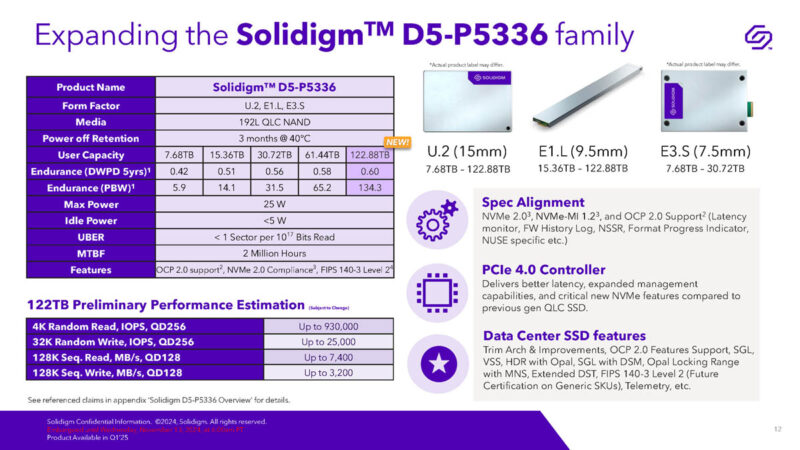
The new capacity point increases the range of the series in the U.2 and eventually the E1.L form factors. The new drives can offer up to 427PBW each of write endurance if the workload is sequential. Something we should point out is that since these are U.2 drives, the density is higher than the Micron 6550 ION 61.44TB PCIe Gen5 NVMe SSD launched yesterday, but it is a lot closer than one might think. Micron’s drive can fit 61.44TB in E3.S so they can be packed more densely just due to dimensions. Solidigm is still around 14-20% ahead in terms if density and has broader system flexibility.
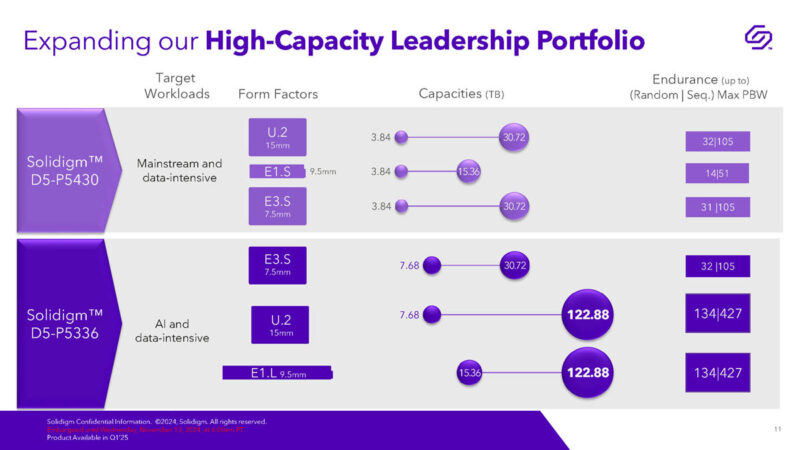
The write endurance might make folks nervous on a QLC SSD. Since these drives are huge, and PCIe Gen4, Solidigm can now run 100% random writes and not even use the write endurance rating up after five years. Of course, running 100% random writes and not having any reads would be strange, but you could.
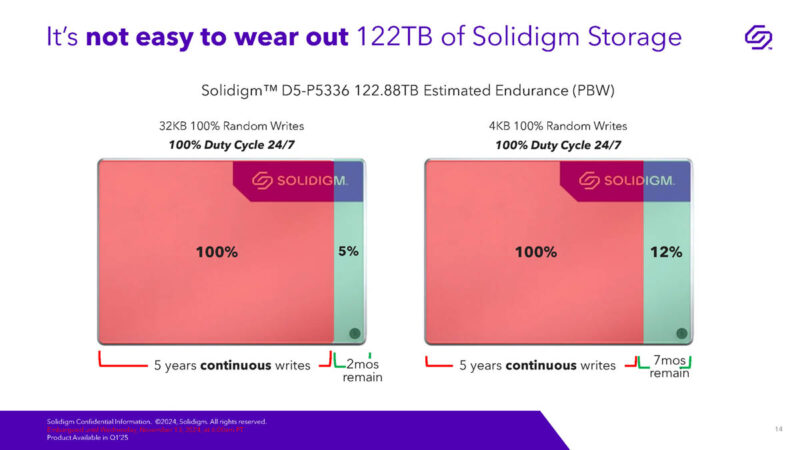
That goes into our piece about how we bought 1347 used data center SSDs to look at SSD Endurance this summer. There, we found that actual SSDs used by other organizations were not written to anywhere near their write endurance ratings. Now Solidigm’s message on the giant QLC SSDs is that write endurance simply does not matter.
Solidigm says that its new 122.88TB SSD is roughly in the range of performance of its 61.44TB SSD. Micon announced yesterday that its new Micron 6550 ION uses PCIe Gen5 and is significantly faster compared to the 6500 ION shown here, while also doubling capacity. Solidigm made this chart before that drive was out.
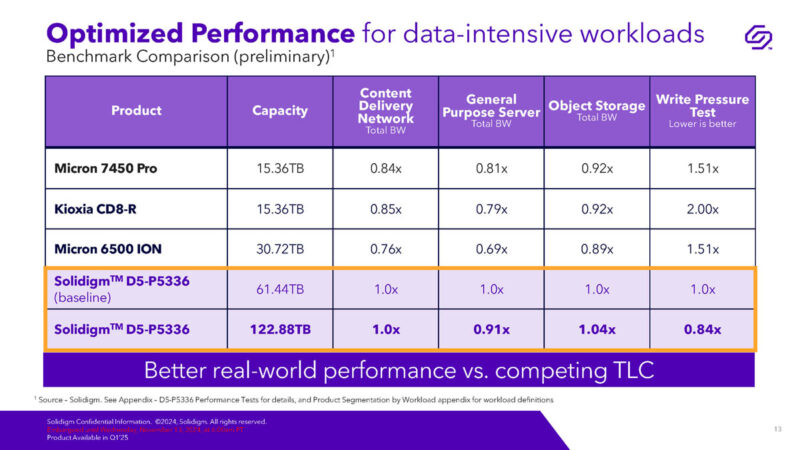
One of the 122.88TB SSD’s biggest benefits is its use of significantly less space. Four 3.5″ hard drives at 30TB for 120TB use around 15x the space of a single U.2 SSD.
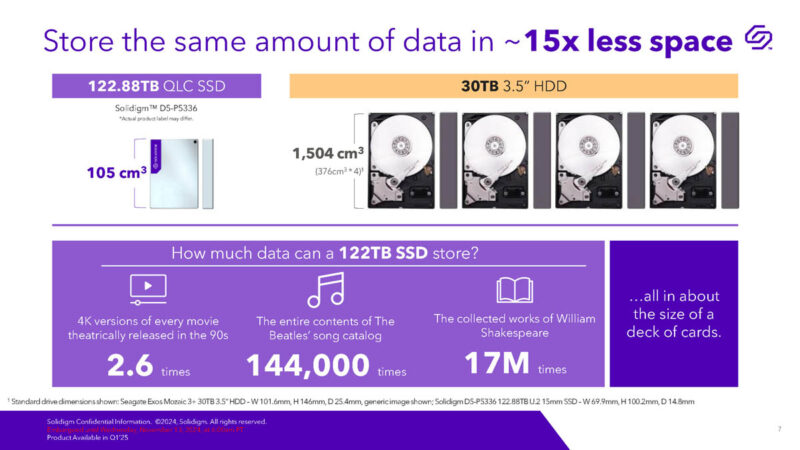
The other benefit is the power efficiency. By using the D5-P5336 122.88TB drive, one can reduce the power consumption required to hit a performance and capacity point.
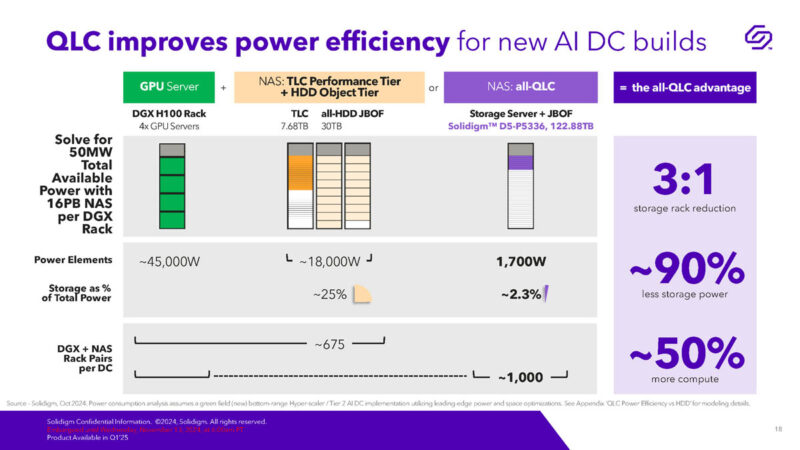
Or another way to look at it is that the percentage of power used for GPU compute in a data center can be higher using these huge SSDs in arrays instead of hard drives.
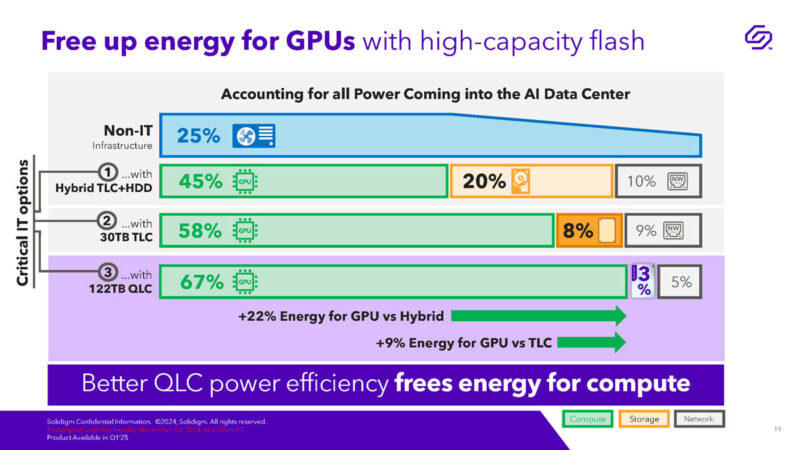
To be clear, large AI clusters are a reason that Solidigm has had a multi-month lead time on the 61.44TB NVMe SSDs. The AI cluster folks figured this out a few quarters ago.
Final Words
In terms of availability, Solidigm says that the 15mm U.2 drives are sampling now, with availability in Q1 2025. Our sense is that if you want drives in Q1 2025, you probably need to be ordering them now. The E1.L version will have availability in Q2 2025.
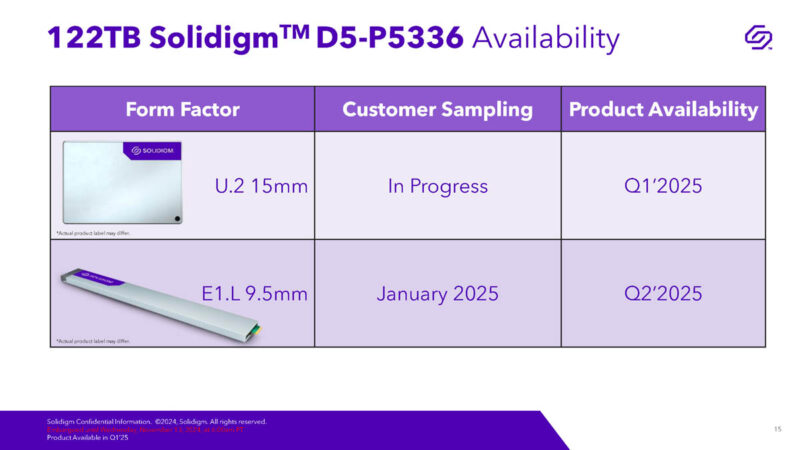
The 122.88TB drives are ones we are extremely excited to see hit the market. Every generation of higher-capacity SSDs increases the use cases where SSDs can displace hard drives. It is also one of the most exciting developments in the flash market in years. For 15+ years we have talked about SSDs in terms of their performance benefits versus hard drives. Now, with these new large-capacity SSDs, the flash-based drives can compete and clearly win on storage density and power efficiency. Those aspects are leading to huge demand for huge drives.

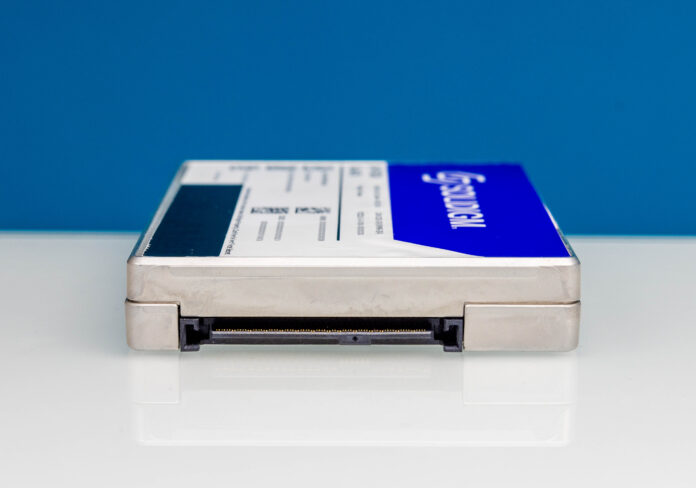


Llama 3 was trained on fifteen trillion tokens, which is about 30TB; what on Earth are the AI people storing on drives twice that size? Prodigious numbers of checkpoints so they can rethink training decisions mid-stream?
Can we please just get lower cost larger drives? I’d like so see ssds compete with the 10tb – 20tb hdds. As a home user sata3 speeds are plenty for my NAS.
Sidenote: why cant i use an email inbox (me+box@example.com) as an email?
What Cynyr said. A couple of 60TB or 122TB SSDs in a NAS enclosure at a reasonable price would be ideal.
That being said: How many years until thousands of these hit the secondary used market? What is the average use case for an AI datacenter drive? Do they use them for 3 years and replace them with something newer/shinier/higher capacity? Or do they ride them into the ground because all the funding is going to GPUs?
@Thomas Womack
They will want client content to train with tenant specific content …so they’re going to take your SPO/OneDrive data and feed it to the training models. And traditional storage models while fast enough for end user access, isn’t going to be fast or large enough for the training models to feed off.
Or
Content creation models…wanting to add more rich data (video/audio) to the mix. Feed it the Matrix so that kids can re-hash it back out into tiktok vids of Morpheus doing a HawkTuah line during Agent Smith’s interrogation.
You can buy 15TB datacentre SSDs used now. Cost/TB is about the same as consumer drives, though.
Just bought three 15TB Micron drives myself, to replace my Samsung QVO 8TB SATA SSDs. The second hand 15TB SSDs off eBay from China were the same price per TB as the Samsungs were brand new, before the recent price hikes. So now per TB they’re not too bad, but of course buying one is a sting to the wallet enough, let alone three. (I have four NVMe slots in an old Dell R720 to use them in, but I figure by the time I fill up these three drives the prices will have come down enough that I can save money on the fourth 15TB drive, or perhaps spring for a 30TB which are still quite a lot more expensive per TB on the second hand market at the moment.)
If you do this yourself make sure you upgrade the firmware first, apparently early Micron firmwares had a tendency to brick themselves for no reason. You could recover the drive by flashing the latest firmware but the data was lost. My drives came with an undocumented firmware version and Micron are pretty cagey about sharing details on it, so it’s not quite plain sailing dealing with second hand enterprise drives.